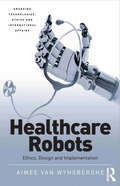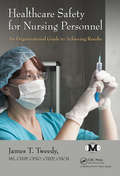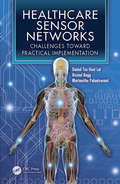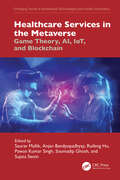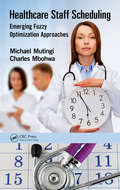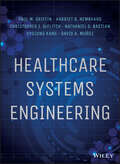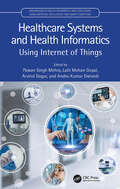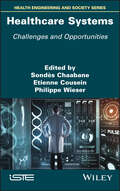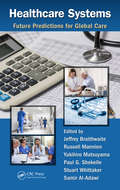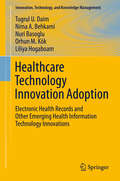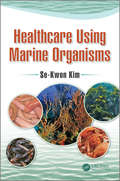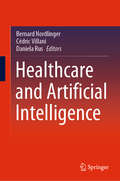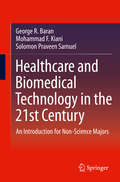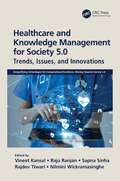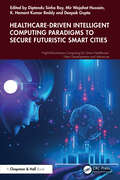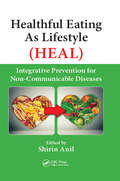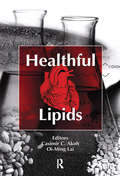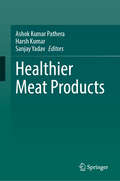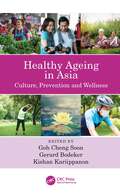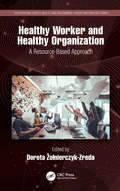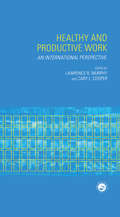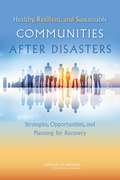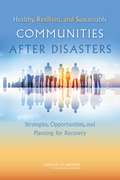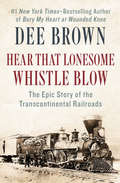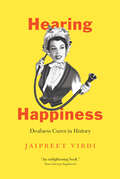- Table View
- List View
Healthcare Robots: Ethics, Design and Implementation (Emerging Technologies, Ethics and International Affairs)
by Aimee van WynsbergheThis study deals with an underexplored area of the emerging technologies debate: robotics in the healthcare setting. The author explores the role of care and develops a value-sensitive ethical framework for the eventual employment of care robots. Highlighting the range of positive and negative aspects associated with the initiative to design and use care robots, it draws out essential content as a guide to future design both reinforcing this study’s contemporary relevance, and giving weight to its prescriptions. The book speaks to, and is meant to be read by, a range of disciplines from science and engineering to philosophers and ethicists.
Healthcare Safety for Nursing Personnel: An Organizational Guide to Achieving Results
by James T. TweedyNursing personnel play an integral role in healthcare and medical delivery organizations. Nurses not only work to keep patients safe, but must also contend with a number of safety and health risks. Illustrating the occupational risks nurses face, Healthcare Safety for Nursing Personnel: An Organizational Guide to Achieving Results addresses healthc
Healthcare Sensor Networks: Challenges Toward Practical Implementation
by Marimuthu Palaniswami Daniel Tze Huei Lai Rezaul BeggHealthcare sensor networks (HSNs) now offer the possibility to continuously monitor human activity and physiological signals in a mobile environment. Such sensor networks may be able to reduce the strain on the present healthcare workforce by providing new autonomous monitoring services ranging from simple user-reminder systems to more advanced mon
Healthcare Services in the Metaverse: Game Theory, AI, IoT, and Blockchain (Emerging Trends in Biomedical Technologies and Health informatics)
by Pawan Kumar Singh Saurav Mallik Anjan Bandyopadhyay Ruifeng Hu Soumadip Ghosh Sujata SwainThis book focuses on game theory approaches utilized on various domains viz., IoT, blockchain and their applications to biomedical and healthcare services. The book bridges the gap between radiologists and Artificial Intelligence (AI)-driven automated systems by investigating various techniques such as game theoretic approach, blockchain technology basically utilized for security, and IoT applied on metaverse. Healthcare Services in the Metaverse: Game Theory, AI, IoT, and Blockchain, identifies the potential areas where game theory and block chain techniques can be harnessed in the metaverse. The book discusses the integration of virtual reality (VR) with augmented reality to identify the new emerging techniques in healthcare to metaverse, where doctors and/or patients can see any kind of operation in the VR metaverse. The authors use game theoretical and blockchain approaches to understand healthcare issues, with the aim of utilizing different technologies of metaverse platform for health informatics. This book is written to help healthcare practitioners and individuals across academia and research, as well as for those who work in biomedical, Internet of Things (IoT), Artificial Intelligence (AI), metaverse, VR, blockchain, and related technologies.
Healthcare Staff Scheduling: Emerging Fuzzy Optimization Approaches
by Charles Mbohwa Michael MutingiHealthcare operations, in hospitals and home healthcare settings, are inundated with complex fuzzy features that impose difficulties in the creation of work schedules. This book presents in-depth research on emerging approaches to healthcare staff scheduling. It starts by reviewing the key issues and challenges inherent in staff scheduling, along with the basic concepts of fuzzy set theory. Examining cutting-edge research applications, it details fuzzy optimization algorithms derived from biologically inspired approaches and fuzzy theory. Facilitating a practical and in-depth understanding of modern fuzzy metaheuristic optimization approaches, the book presents recent research on multi-criteria algorithms and their applications in healthcare operations, particularly staff scheduling.
Healthcare Systems Engineering
by Paul M. Griffin Harriet B. Nembhard Christopher J. DeFlitch Nathaniel D. Bastian Hyojung Kang David A. MunozApply engineering and design principles to revitalize the healthcare delivery system Healthcare Systems Engineering is the first engineering book to cover this emerging field, offering comprehensive coverage of the healthcare system, healthcare delivery, and healthcare systems modeling. Written by leading industrial engineering authorities and a medical doctor specializing in healthcare delivery systems, this book provides a well-rounded resource for readers of a variety of backgrounds. Examples, case studies, and thoughtful learning activities are used to thoroughly explain the concepts presented, including healthcare systems, delivery, quantification, and design. You'll learn how to approach the healthcare industry as a complex system, and apply relevant design and engineering principles and processes to advance improvements. Written with an eye toward practicality, this book is designed to maximize your understanding and help you quickly apply toward solutions for a variety of healthcare challenges. Healthcare systems engineering is a new and complex interdisciplinary field that has emerged to address the myriad challenges facing the healthcare industry in the wake of reform. This book functions as both an introduction and a reference, giving you the knowledge you need to move toward better healthcare delivery. Understand the healthcare delivery context Use appropriate statistical and quantitative models Improve existing systems and design new ones Apply systems engineering to a variety of healthcare contexts Healthcare systems engineering overlaps with industrial engineering, operations research, and management science, uniting the principles and practices of these fields together in pursuit of optimal healthcare operations. Although collaboration is focused on practitioners, professionals in information technology, policy and administration, public health, and law all play crucial roles in revamping health care systems. Healthcare Systems Engineering is a complete and authoritative reference for stakeholders in any field.
Healthcare Systems and Health Informatics: Using Internet of Things (Innovations in Health Informatics and Healthcare)
by Pawan Singh MehraThis book covers the fundamentals of IoT and healthcare systems for carrying out system architectures, protocols, wearable devices, and interoperability. It explores major challenges in artificial intelligence (AI) and smart computing in resource-constrained IoT-based applications along with cost, energy efficiency, and the availability of quality service. Healthcare Systems and Health Informatics: Using Internet of Things explores the role of AI and smart computing in health informatics and healthcare with an emphasis on clinical data management and analysis for precise prediction and prompt action. It presents cutting-edge tracking, monitoring, real-time assistance, and security for IoT in healthcare and broadly discusses wearable sensors and IoT devices and their role in smart living assistance. The book goes on to describe a system model and architecture for a clear picture of energy conservation–based IoT in healthcare and explains the challenges and opportunities with IoT-based healthcare industries. A study of the threats and impacts, along with the need for information security, is also included. The chapters are written by experts in the field, and this book provides a comprehensive description of the important aspects of IoT and health from a beginner- to advanced-level perspective and is ideal for researchers, academicians, students, persons in industry, technologists, and entrepreneurs.
Healthcare Systems: Challenges and Opportunities
by Etienne Cousein Philippe Wieser Sondès ChaabaneThis book is centered around the development of agile, high-performing healthcare institutions that are well integrated into their environment. The aim is to take advantage of artificial intelligence, optimization and simulation methods to provide solutions to prevent, anticipate, monitor and follow public health developments in order to intervene at the right time, using tools and resources that are both appropriate and effective.The focus is on the people involved – the patients, as well as medical, technical and administrative staff – in an effort to provide an efficient healthcare and working environment that meets safety, quality and productivity requirements.Heathcare Systems has been written by healthcare professionals, researchers in science and technology as well as in the social sciences and humanities from various French-speaking countries. It explores the challenges and opportunities presented by digital technology in our practices, organizations and management techniques.
Healthcare Systems: Future Predictions for Global Care
by Jeffrey Braithwaite Russell Mannion Yukihiro Matsuyama Stuart Whittaker Samir Al-Adawi Paul G. ShekelleIn this book, we invited 146 authors with expertise in health policy, systems design, management, research, or practice, from each of the countries included, to consider health reforms or systems improvements in their country or region. The resulting case studies, of 52 individual countries and five regional groupings, cover 152 countries or territories, or three-quarters of the world’s nations. Each chapter author was asked to think 5–15 years into the future and make a prediction on how their health system could be strengthened as a result of the successful unfolding of their case study. The types of projects our authors have chosen to explicate into the future are wide-ranging. They vary from e-consultation services in Estonia, achieving universal health coverage in Argentina and Mexico, reforming long-term care in the Netherlands, reassessing care for the aging population and the frail elderly in Australia, streamlining the health system through Lean Thinking in Nigeria, using regulation to improve care in South Africa, developing a new accreditation model in Turkey, through to a critique of physician specialization in Russia and applying IT initiatives to improve care in China, Lebanon, Taiwan, Papua New Guinea, the United Arab Emirates, Venezuela and Wales. Chapter writers recognized that the improvement work they were doing was part of a moving target. There was general agreement that the effective use of limited resources and overcoming hurdles and constraints were crucial to enhancing health systems in order to deliver better care over the medium term. While some initiatives required considerable funding, many were relatively inexpensive. These case studies demonstrate ways in which fruitful application of partnerships and creativity can make considerable gains in strengthening healthcare delivery systems. Features The third book in a series on international health reform Involves 146 contributing authors, five regional editors, a series editor and a highly skilled support team to explore sustainable improvement in health systems in the future Encompasses a time horizon of the next 5–15 years Covers 152 countries or territories, with 52 individual countries and an analysis of five regional groupings comprising 100 countries
Healthcare Technology Innovation Adoption
by Nuri Basoglu Tugrul U. Daim Nima A. Behkami Orhun M. Kök Liliya HogaboamThis book aims to study the factors effecting the adoption and diffusion of Health Information Technology (HIT) innovation. It analyses the adoption processes of various tools and applications, particularly Electronic Health Records (EHR), highlighting the impact on various sectors of the healthcare system, such as physicians, administration and patient care, while also identifying the various pitfalls and gaps in the literature. With the various challenges currently facing the United States healthcare system, the study, adoption and diffusion of healthcare technology innovation, particularly HIT, is imperative to achieving national goals. This book is organized into three sections. Section one reviews theories and applications for the diffusion of Health Care Technologies. Section two evaluates EHR technology, including the barriers and enables in adoption and alternative technologies. Finally, section three examines the factors impacting the adoption of EHR systems. This book will be a key source for students, academics, researchers, practitioners, professionals and policy-makers.
Healthcare Using Marine Organisms
by Se-Kwon Kim"The chapters are organized well, and the preface explains how the concept of food is changing over time and how marine organisms are considered as healthy food."—P.N. Sudha, DKM College for Women, Tamil Nadu, India The relationship between food and health has been a growing concern in modern society, and the importance of information on their connection has elevated accordingly. People are becoming prone to diseases due to the deterioration of the environment. Despite a growing interest in preventative medicine in the healthcare sector, few medications can be called preventative drugs. Foods may exhibit completely different functions in a living body, depending on whether their components are simple substances providing energy and nutrition, or valid "functional entities." This book covers all aspects of healthcare solutions through marine-derived materials, with twenty-six chapters exploring an array of topics pertaining to human health in everyday life. Beginning with an introduction to food functionality and disease presentation, Chapters Two to Nine discuss chitin, chitosan, and the production and application of chitosan oligosaccharides regarding anti-cancer, anti-aging, and antioxidant activity. Furthermore, utilization of these cationic polysaccharides in artificial skin development, the prevention of alcohol consumption, dentistry, systemic diseases prevention and Alzheimer dementia are discussed in subsequent chapters. In Chapters Ten and Thirteen, I discuss obesity, osteoporosis, sexual dysfunction and sleep disorders using fisheries products. Additionally, Chapters Fourteen to Eighteen detail the use of marine algae to treat diabetics, allergy, asthma, AIDS and hair loss, as well as the use of fisheries products for hypertension and athlete’s foot. Chapters Twenty-Two through Twenty-Six then shed light on the anti-aging effects of fish, the abundance of taurine in shellfish, antifreeze protein, food shortages through fish breeding, and cosmeceutical product development using marine organisms.
Healthcare and Artificial Intelligence
by Cédric Villani Bernard Nordlinger Daniela RusThis book provides an overview of the role of AI in medicine and, more generally, of issues at the intersection of mathematics, informatics, and medicine. It is intended for AI experts, offering them a valuable retrospective and a global vision for the future, as well as for non-experts who are curious about this timely and important subject. Its goal is to provide clear, objective, and reasonable information on the issues covered, avoiding any fantasies that the topic “AI” might evoke. In addition, the book seeks to provide a broad kaleidoscopic perspective, rather than deep technical details.
Healthcare and Biomedical Technology in the 21st Century
by George R. Baran Mohammad F. Kiani Solomon Praveen SamuelHealthcare and Biotechnology in the 21st Century: Concepts and Case Studies introduces students not pursuing degrees in science or engineering to the remarkable new applications of technology now available to physicians and their patients and discusses how these technologies are evolving to permit new treatments and procedures. The book also elucidates the societal and ethical impacts of advances in medical technology, such as extending life and end of life decisions, the role of genetic testing, confidentiality, costs of health care delivery, scrutiny of scientific claims, and provides background on the engineering approach in healthcare and the scientific method as a guiding principle. This concise, highly relevant text enables faculty to offer a substantive course for students from non-scientific backgrounds that will empower them to make more informed decisions about their healthcare by significantly enhancing their understanding of these technological advancements.
Healthcare and Knowledge Management for Society 5.0: Trends, Issues, and Innovations (ISSN)
by Vineet KansalHealthcare and knowledge management is the need of the era; this book investigates various challenges faced by practitioners in this area. It also covers the work to be done in the healthcare sector and the use of different computing techniques for better insight and decision-making. Healthcare and Knowledge Management for Society 5.0: Trends, Issues, and Innovations showcases the benefits of computing techniques used for knowledge management in the field of healthcare in the futuristic perspective of having a human-centric society 5.0. The book includes topics related to the use of technologies like artificial intelligence, machine learning, deep learning, Internet of Things, blockchain, and sensors for effective healthcare and management. Case studies are included for easy comprehension and the book covers the most up-to-date research in the field. The use of techniques like artificial intelligence in the field of knowledge management is also discussed.This book is intended for researchers and academicians to explore new ideas, techniques, and tools. Researchers working in interdisciplinary research can also find many interesting topics which will pave the way for a new arena in healthcare and knowledge management.
Healthcare-Driven Intelligent Computing Paradigms to Secure Futuristic Smart Cities (High-Performance Computing for Smart Healthcare)
by Deepak Gupta Diptendu Sinha Roy Mir Wajahat Hussain K. Hemant Kumar ReddyHealthcare-Driven Intelligent Computing Paradigms to Secure Futuristic Smart Cities presents the applications of the healthcare sector in the context of futuristic smart cities. It explores various applications like the advancements in computational and network models along with the innovative paradigms for an able healthcare model. The book discusses the state-of-the-art intelligent network and computing paradigms and machine learning models for robust healthcare. This book is for academicians, researchers, and entrepreneurs working on healthcare-driven intelligent computing paradigms to secure futuristic smart cities. It includes several aspects of the challenges faced by a futuristic smart city in healthcare, includes challenges emanating from the immense data generated by the wearable sensors, data analysis, and security concerns owing to the patient-related data. It works as a pertinent resource on how cutting-edge technologies can be integrated to aptly provide solutions for the numerous challenges faced by the healthcare industry. Includes several use cases, practical challenges, and solutions for executing smart healthcare.Features Covers a multitude of computing paradigms viz; Cloud computing, Fog Computing, and Mist Computing Healthcare is discussed leveraging smart city, so it can potentially identify the gaps and present some newer use cases to handle future pandemics The network aspect is also covered with an inclusion of the next-generation paradigm which is Software Defined Networking (SDN) Security and privacy issues are considered, which is crucial to handle security-related aspects Machine Learning models are also discussed to provide any entrepreneur develop a business model involving cutting-edge technologies This book is for academicians, researchers, and entrepreneurs working on healthcare-driven intelligent computing paradigms to secure futuristic smart cities.
Healthful Eating As Lifestyle (HEAL): Integrative Prevention for Non-Communicable Diseases
by Shirin AnilNon-communicable diseases (NCDs) are chronic diseases of long duration and generally slow progression, including cardiovascular diseases, cancers, chronic respiratory diseases, and diabetes. Morbidity and mortality due to non-communicable disease has risen tremendously over the years globally. Healthful Eating As Lifestyle (HEAL): Integrative Prevention for Non-Communicable Diseases highlights the importance of HEAL as an intervention for the prevention and cure of NCDs, as well as the prevention and treatment of its risk factors like hypertension, high cholesterol, obesity, smoking, increased alcohol intake, and insufficient physical activity. It provides motivational strategies for users of all ages, gender, and strata for healthful eating, both in developed and developing countries. The book is composed of evidence-based information and illustrations by 32 experts, including renowned researchers from academia, government, and non-governmental organizations in the field of NCDs and nutrition from 11 countries across five continents. Furthermore, the book discusses the dose-response relationship of healthful food with NCDs and its risk factor. It also includes nutritional home remedies for prevention and control of NCDs along with safety concerns and case studies at the end of all chapters for translating theory into practice.
Healthful Lipids
by Casimir C. AkohHealthful Lipids addresses critical and current regulatory issues and emerging technologies, as well as the efforts made toward the production of healthier lipids. This book examines the latest technological advancements and the emerging technologies in processing and analysis, health-related concerns, and strategies used in the production and appl
Healthier Meat Products
by Sanjay Yadav Ashok Kumar Pathera Harsh KumarMeat products are a rich source of essential nutrients, including high-quality proteins, B-complex vitamins and minerals. The perception of meat as a beneficial source of nutrients and a healthy food has been somewhat diminished due to its elevated levels of saturated fatty acids and cholesterol, which have frequently been associated with various health complications. Over the previous decades, scholars have tried to enhance the perception of processed meat products by designing and formulating healthier processed and value-added meat products. This has been achieved by incorporating ingredients that are deemed beneficial to health or by decreasing or eliminating detrimental constituents. The findings of such research have been disseminated through scholarly publications, including research articles and patents. Healthier Meat Products introduces readers to meat products enriched with antioxidants, antimicrobials, bioactivecompounds, dietary fibers and lower levels of salt and nitrite, with a focus on healthier choices. By exploring these alternative approaches, readers gain a deeper understanding of how these products are developed, their nutritional profiles and their potential to transform our food system. The book covers the most recent advances in the production of processed meat products that promote health and wellness based on the existing scientific literature.
Healthy Ageing in Asia: Culture, Prevention and Wellness
by Gerard Bodeker Kishan Kariippanon Goh Cheng SoonAsia is the world’s most populous region and has the highest per capita number of older people in the world. It is also home to the healthy ageing traditions of Ayurveda and Chinese Medicine and the rich regional traditions of Japan, Korea, Southeast Asia, and South Asia. This book addresses policies related to ageing, traditional Asian approaches to ageing, an integrated medical system approaches to ageing, ageing in place, and community empowerment. Features Presents information on The 100-Year Life. As a counterpoint to focussing on the frail elderly, Japan is promoting the ‘100-Year Life Society’, a societal model in which all citizens are dynamically engaged and productive throughout the lifespan to reach a healthy 100 years of age. Discusses a framework for optimization of Ageing in Place or staying at home as this is a desired option for most older people. Presents evidence for exercise and movement in healthy aging with guidelines in different states of ageing. Features information on how to improve mental wellbeing in cognitive decline, isolation and loneliness, poor nutrition, and reduced mobility. Creates an understanding of loss and bereavement through processes and the impact of loss. Provides information on developments in health technology to optimize efficiency, accuracy, and effectiveness of providers. Details health insurance options including coverage for traditional as well as modern medical services, provides models for other countries in the region. Lists coping skills or abilities to help older people to be more independent and in control of their lives. Features information on Asian herbs, spices and foods in healthy ageing across the lifepsan and specifically in addressing age-related health issues. "What is required is a new culture based on the science in which older people are expected to remain, or become increasingly active, physically, cognitively and emotionally maintaining or strengthening a strong sense of purpose. Europe is looking to Asia because this culture is more prevalent there than in Europe. The core theme is not one of ‘caring’ for a passive subset of the population but of promoting lifelong learning because knowledge is the elixir of life." - Professor Sir Muir Gray, Founding Director, The Optimal Ageing Programme & Professor in the Nuffield Department of Surgery, University of Oxford
Healthy Worker and Healthy Organization: A Resource-Based Approach (Occupational Safety, Health, and Ergonomics)
by Dorota Żołnierczyk-ZredaThis book presents research on the determinants of workers’ health (physical and mental well-being) and the organization’s health (performance and culture). It addresses the impact of psychosocial working conditions on workers’ well-being, and their performance, productivity, innovation, and morale at work. Discusses how to manage workers to enable them to be engaged and creative Raises employee awareness on how to maintain good physical and mental health at work Covers how to work beyond retirement age Presents how to design a work environment that prevents counterproductive behaviors Covers work–life balance and how it can affect work This book is aimed at professionals, postgraduate students, scientists, and practitioners in the fields of work and health psychology, management, occupational health and safety, and human resource management.
Healthy and Productive Work: An International Perspective
by Cary L. Cooper Lawrence R. MurphyThe Enterprise Culture of the 1980s helped transform economies of Western Europe, but left behind a legacy of stress, both for managers and shop floor workers. The cost to business is seen in absenteeism, reduced productivity, compensation claims, health insurance and direct medical costs, which in the US cost approximately $150 billion a year. Str
Healthy, Resilient, and Sustainable Communities After Disasters: Strategies, Opportunities, and Planning for Recovery
by Committee on Post-Disaster Recovery of a Community's Public Health Medical Social ServicesIn the devastation that follows a major disaster, there is a need for multiple sectors to unite and devote new resources to support the rebuilding of infrastructure, the provision of health and social services, the restoration of care delivery systems, and other critical recovery needs. In some cases, billions of dollars from public, private and charitable sources are invested to help communities recover. National rhetoric often characterizes these efforts as a "return to normal. " But for many American communities, pre-disaster conditions are far from optimal. Large segments of the U. S. population suffer from preventable health problems, experience inequitable access to services, and rely on overburdened health systems. A return to pre-event conditions in such cases may be short-sighted given the high costs - both economic and social - of poor health. Instead, it is important to understand that the disaster recovery process offers a series of unique and valuable opportunities to improve on the status quo. Capitalizing on these opportunities can advance the long-term health, resilience, and sustainability of communities - thereby better preparing them for future challenges. "Healthy, Resilient, and Sustainable Communities After Disasters" identifies and recommends recovery practices and novel programs most likely to impact overall community public health and contribute to resiliency for future incidents. This book makes the case that disaster recovery should be guided by a healthy community vision, where health considerations are integrated into all aspects of recovery planning before and after a disaster, and funding streams are leveraged in a coordinated manner and applied to health improvement priorities in order to meet human recovery needs and create healthy built and natural environments. The conceptual framework presented in "Healthy, Resilient, and Sustainable Communities After Disasters" lays the groundwork to achieve this goal and provides operational guidance for multiple sectors involved in community planning and disaster recovery. "Healthy, Resilient, and Sustainable Communities After Disasters" calls for actions at multiple levels to facilitate recovery strategies that optimize community health. With a shared healthy community vision, strategic planning that prioritizes health, and coordinated implementation, disaster recovery can result in a communities that are healthier, more livable places for current and future generations to grow and thrive - communities that are better prepared for future adversities.
Healthy, Resilient, and Sustainable Communities After Disasters: Strategies, Opportunities, and Planning for Recovery
by Medical Social Services Committee on Post-Disaster Recovery of a Community’s Public HealthIn the devastation that follows a major disaster, there is a need for multiple sectors to unite and devote new resources to support the rebuilding of infrastructure, the provision of health and social services, the restoration of care delivery systems, and other critical recovery needs. In some cases, billions of dollars from public, private and charitable sources are invested to help communities recover. National rhetoric often characterizes these efforts as a "return to normal. " But for many American communities, pre-disaster conditions are far from optimal. Large segments of the U. S. population suffer from preventable health problems, experience inequitable access to services, and rely on overburdened health systems. A return to pre-event conditions in such cases may be short-sighted given the high costs - both economic and social - of poor health. Instead, it is important to understand that the disaster recovery process offers a series of unique and valuable opportunities to improve on the status quo. Capitalizing on these opportunities can advance the long-term health, resilience, and sustainability of communities - thereby better preparing them for future challenges. "Healthy, Resilient, and Sustainable Communities After Disasters" identifies and recommends recovery practices and novel programs most likely to impact overall community public health and contribute to resiliency for future incidents. This book makes the case that disaster recovery should be guided by a healthy community vision, where health considerations are integrated into all aspects of recovery planning before and after a disaster, and funding streams are leveraged in a coordinated manner and applied to health improvement priorities in order to meet human recovery needs and create healthy built and natural environments. The conceptual framework presented in "Healthy, Resilient, and Sustainable Communities After Disasters" lays the groundwork to achieve this goal and provides operational guidance for multiple sectors involved in community planning and disaster recovery. "Healthy, Resilient, and Sustainable Communities After Disasters" calls for actions at multiple levels to facilitate recovery strategies that optimize community health. With a shared healthy community vision, strategic planning that prioritizes health, and coordinated implementation, disaster recovery can result in a communities that are healthier, more livable places for current and future generations to grow and thrive - communities that are better prepared for future adversities.
Hear That Lonesome Whistle Blow: The Epic Story of the Transcontinental Railroads
by Dee Brown&“A fascinating story&” of the railways that linked America from the #1 New York Times–bestselling author of Bury My Heart at Wounded Knee (The Washington Post). Hear that Lonesome Whistle Blow unspools the history of the beginnings of the American railroad system. By the mid-nineteenth century, settlers in Missouri and California were separated by a vast landscape that dwarfed and isolated them, conquerable only by &“the demonic power of the Iron Horse and its bands of iron track.&” Although the building of the great railroad is commonly known as a story of romance, adventure, and progress, it also has a dark side, as profiteers decimated American Indian tribes, exploited workers, and destroyed ecosystems. Despite this, by the turn of the twentieth century, five major railroads would span the continent. This account vividly illustrates the railroad builders&’ breathtaking skill, ambition, and ingenuity. . Brown compellingly tells a high-stakes tale, an exhilarating history that still holds lessons for today. This ebook features an illustrated biography of Dee Brown including rare photos from the author&’s personal collection.
Hearing Happiness: Deafness Cures in History (Chicago Visions and Revisions)
by Jaipreet VirdiAt the age of four, Jaipreet Virdi’s world went silent. A severe case of meningitis left her alive but deaf, suddenly treated differently by everyone. Her deafness downplayed by society and doctors, she struggled to “pass” as hearing for most of her life. Countless cures, treatments, and technologies led to dead ends. Never quite deaf enough for the Deaf community or quite hearing enough for the “normal” majority, Virdi was stuck in aural limbo for years. It wasn’t until her thirties, exasperated by problems with new digital hearing aids, that she began to actively assert her deafness and reexamine society’s—and her own—perception of life as a deaf person in America. Through lyrical history and personal memoir, Hearing Happiness raises pivotal questions about deafness in American society and the endless quest for a cure. Taking us from the 1860s up to the present, Virdi combs archives and museums in order to understand the long history of curious cures: ear trumpets, violet ray apparatuses, vibrating massagers, electrotherapy machines, airplane diving, bloodletting, skull hammering, and many more. Hundreds of procedures and products have promised grand miracles but always failed to deliver a universal cure—a harmful legacy that is still present in contemporary biomedicine. Weaving Virdi’s own experiences together with her exploration into the fascinating history of deafness cures, Hearing Happiness is a powerful story that America needs to hear.
